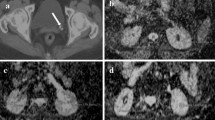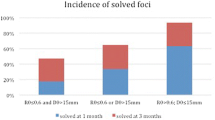Abstract
Aims
This study aims to evaluate the (a) accuracy of conventional and diffusion-weighted-imaging (DWI) sequences in the diagnosis of acute pyelonephritis and (b) minimum apparent diffusion coefficient (ADC) values for the diagnosis of acute pyelonephritis and the differentiation of renal abscesses from acute pyelonephritis.
Materials and methods
Ultrasound, conventional MRI sequences, and DWI were used to evaluate the kidneys in 68 patients suspected to have acute pyelonephritis. Multiple similar regions of interest (ROIs) were placed over the renal parenchyma with visually identifiable diffusion restriction, over the non-diffusion-restricted renal parenchyma of affected kidneys and over the normal kidneys. Corresponding minimum ADCs were noted for analysis. Pyelonephritis was confirmed based on clinical criteria, laboratory findings, and by resolution/development of known complications of pyelonephritis.
Result
DWI showed the highest sensitivity(100%), while DWI read with T2-weighted imaging (both being positive) showed the highest specificity(100%) for the diagnosis of acute pyelonephritis in our population with a high baseline creatinine. The minimum-ADC of the nephritic diffusion-restricted area in patients with confirmed pyelonephritis was significantly lower than the minimum-ADC in patients without pyelonephritis [(0.934 ± 0.220, mean ± SD) vs (1.804 ± 0.404) × 10−3 s/mm2] (p < 0.001). ROC cut-off of minimum-ADC for the diagnosis of acute pyelonephritis was 1.202 × 10−3 s/mm2 (area under curve 0.978). The minimum-ADC of the abscesses were significantly lower when compared to the minimum-ADC of the nephritic diffusion-restricted portion of the same kidney [(0.633 ± 0.248) vs (0.850 ± 0.191) × 10−3 s/mm2] (p < 0.001).
Conclusion
DWI is an excellent stand-alone imaging tool that can be combined with conventional sequences for the diagnosis of APN even in patients with high serum-creatinine or other contraindications to intravenous contrast. Further, ADC values can be used to differentiate between renal abscesses and uncomplicated pyelonephritis.






Similar content being viewed by others
Data Availability
The dataset used for this study is publicly available [32].
References
Johnson JR, Russo TA (2018) Acute pyelonephritis in adults. N Engl J Med 378:48–59. https://doi.org/10.1056/NEJMcp1702758
Czaja CA, Scholes D, Hooton TM and Stamm WE (2007) Population-based epidemiologic analysis of acute pyelonephritis. Clin Infect Dis 45(3):273–280. Available from: http://www.ncbi.nlm.nih.gov/pubmed/17599303
Ramakrishnan K, Scheid DC (2005) Diagnosis and management of acute pyelonephritis in adults. Am Fam Physician 71:933–942
Craig WD, Wagner BJ, Travis MD (2008) Pyelonephritis: radiologic-pathologic review. Radiographics 28:255–276
Chiew YF (1996) Candidal renal papillary necrosis: report of a case and review. Singapore Med J 37:119–121
Goyal A, Sharma R, Bhalla AS, Gamanagatti S, Seth A (2012) Diffusion-weighted MRI in assessment of renal dysfunction. Indian J Radiol Imaging 22:155–159
Chan JHM, Tsui EYK, Luk SH, Fung SL, Cheung YK, Chan MSM et al (2001) MR diffusion-weighted imaging of kidney: differentiation between hydronephrosis and pyonephrosis. Clin Imaging 25:110–113
Verswijvel G, Vandecaveye V, Gelin G, Vandevenne J, Grieten M, Horvath M et al (2002) Diffusion-weighted MR imaging in the evaluation of renal infection: preliminary results. JBR-BTR 85:100–103
Zielonko J, Studniarek M, Markuszewski M (2003) MR urography of obstructive uropathy: diagnostic value of the method in selected clinical groups. Eur Radiol 13:802–809
Piccoli G, Consiglio V, Deagostini M, Serra M, Biolcati M, Ragni F et al (2011) The clinical and imaging presentation of acute “non complicated” pyelonephritis: a new profile for an ancient disease. BMC nephrology 12:68
Vivier PH, Sallem A, Beurdeley M, Lim RP, Leroux J, Caudron J et al (2014) MRI and suspected acute pyelonephritis in children: comparison of diffusion-weighted imaging with gadolinium-enhanced T1-weighted imaging. Eur Radiol 24:19–25
De Pascale A, Piccoli GB, Priola SM, Rognone D, Consiglio V, Garetto I et al (2013) Diffusion-weighted magnetic resonance imaging: new perspectives in the diagnostic pathway of non-complicated acute pyelonephritis. Eur Radiol 23:3077–3086
Yalçin-Şafak K, Ayyildiz M, Ünel SY, Umarusman-Tanju N, Akça A, Baysal T (2016) The relationship of ADC values of renal parenchyma with CKD stage and serum creatinine levels. Eur J Radiol Open 3:8–11
Xu Y, Wang X, Jiang X (2007) Relationship between the renal apparent diffusion coefficient and glomerular filtration rate: preliminary experience. J Magn Reson Imaging 26:678–681
Thoeny HC, De Keyzer F, Oyen RH, Peeters RR (2005) Diffusion-weighted MR imaging of kidneys in healthy volunteers and patients with parenchymal diseases: initial experience. Radiology 235:911–917
Toyoshima S, Noguchi K, Seto H, Shimizu M, Watanabe N (2000) Functional evaluation of hydronephrosis by diffusion-weighted MR imaging. Relationship between apparent diffusion coefficient and split glomerular filtration rate. Acta radiol. 41:642–646
Reimer P, Parizel PM, Meaney JFM, Stichnoth FA (2010) Clinical MR imaging (Third Edition): a practical approach. Springer, Heidelberg, pp 1–23
Piccoli GB, Consiglio V, Colla L, Mesiano P, Magnano A, Burdese M et al (2006) Antibiotic treatment for acute “uncomplicated” or “primary” pyelonephritis: a systematic, “semantic revision.” Int J Antimicrob Agents 28:49–63
Nickavar A, Safaeian B (2015) Radiologic and clinical evaluation of children with first febrile urinary tract infection. Int J Pediatr Adolesc Med 2:24–28
Vourganti S, Agarwal PK, Bodner DR, Dogra VS (2006) Ultrasonographic evaluation of renal infections. Radiol Clin 44:763–775
June CH, Browning MD, Smith LP, Wenzel DJ, Pyatt RS, Checchio LM et al (1985) Ultrasonography and computed tomography in severe urinary tract infection. Arch Intern Med 145:841–845
Henninger B, Reichert M, Haneder S, Schoenberg SO, Michaely HJ (2013) Value of diffusion-weighted MR imaging for the detection of nephritis. Sci World J 2013:348105. https://doi.org/10.1155/2013/348105
Rathod SB, Kumbhar SS, Nanivadekar A, Aman K (2015) Role of diffusion-weighted MRI in acute pyelonephritis: a prospective study. Acta Radiol 56:244–249
Rollino C, Beltrame G, Ferro M, Quattrocchio G, Sandrone M, Quarello F (2012) Acute pyelonephritis in adults: a case series of 223 patients. Nephrol Dial Transplant 27:3488–3493
Faletti R, Cassinis MC, Fonio P, Grasso A, Battisti G, Bergamasco L et al (2013) Diffusion-weighted imaging and apparent diffusion coefficient values versus contrast-enhanced MR imaging in the identification and characterisation of acute pyelonephritis. Eur Radiol 23:3501–3508
Blandino A, Gaeta M, Minutoli F, Salamone I, Magno C, Scribano E (2002) MR urography of the ureter. Am J Roentgenol 179:1307–1314
Memarsadeghi M, Riccabona M, Heinz-Peer G (2005) MR urography: principles, examination techniques, indications. Radiologe 45:915–923
Leyendecker JR, Barnes CE, Zagoria RJ (2008) MR urography: techniques and clinical applications. Radiographics 28:23–46
Garcia-Valtuille R, Garcia-Valtuille AI, Abascal F, Cerezal L, Arguello MC (2006) Magnetic resonance urography: a pictorial overview. Br J Radiol 79:614–626
Smith AD, Nikolaidis P, Khatri G, Chong ST, De Leon AD, Ganeshan D, Gore JL, Gupta RT, Kwun R, Lyshchik A, Nicola R (2022) ACR Appropriateness Criteria® acute pyelonephritis: 2022 update. J Am Coll Radiol 19(11):S224–S239
Huynh AD, Sweet DE, Feldman MK, Remer EM (2022) Imaging of renal emergencies: review of infectious, hemorrhagic, vascular, and traumatic etiologies. Br J Radiol 95(1137):20211151
Pinto D (2023) Pyelonephritis data upload - repository.pdf. figshare. Dataset. https://doi.org/10.6084/m9.figshare.22201006.v1
Author information
Authors and Affiliations
Corresponding author
Ethics declarations
Conflict of interest
The authors declare that they have no conflict of interest.
Additional information
Publisher's note
Springer Nature remains neutral with regard to jurisdictional claims in published maps and institutional affiliations.
Rights and permissions
Springer Nature or its licensor (e.g. a society or other partner) holds exclusive rights to this article under a publishing agreement with the author(s) or other rightsholder(s); author self-archiving of the accepted manuscript version of this article is solely governed by the terms of such publishing agreement and applicable law.
About this article
Cite this article
Pinto, D.S., George, A., Johny, J. et al. Role of MRI in the evaluation of acute pyelonephritis in a high-risk population with renal dysfunction: a prospective study. Emerg Radiol 30, 285–295 (2023). https://doi.org/10.1007/s10140-023-02122-z
Received:
Accepted:
Published:
Issue Date:
DOI: https://doi.org/10.1007/s10140-023-02122-z




